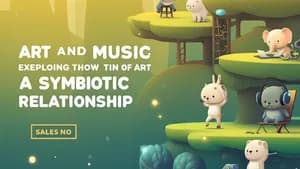The influence of musical forms on artistic styles is undeniable. This article examines how musical periods like Baroque, Romantic, and Modernism have inspired distinct artistic movements, showcasing the interplay between sound and visual expression.
The Baroque Era: Opulence and Drama
Imagine a grand palace, lavishly decorated with intricate sculptures, paintings, and tapestries. This is the visual embodiment of the Baroque era, a period in European history spanning roughly the 17th and early 18th centuries. Just like the grandeur of a palace, Baroque music is known for its dramatic contrasts, elaborate ornamentation, and emotional intensity. Think of the powerful chords and dramatic flourishes of Bach's organ music, or the passionate melodies of Vivaldi's concertos. This same sense of drama and grandeur is reflected in Baroque art. You can see it in the dramatic use of light and shadow in Caravaggio's paintings, the swirling movement in Bernini's sculptures, and the opulent detail in Vermeer's domestic scenes.
When studying Baroque art, pay attention to the use of light and shadow, the dramatic poses of figures, and the overall sense of movement and energy. How do these elements create a sense of emotional intensity? What are the key themes being explored? By understanding the musical influences of the era, you can gain a deeper appreciation for the visual arts of the Baroque period.
The Romantic Era: Passion and Emotion
The Romantic period (late 18th to mid-19th century) was a time of great social and political upheaval, characterized by a strong emphasis on individualism, emotion, and imagination. These themes are reflected in the music of the era. Think of the soaring melodies of Beethoven's symphonies, the passionate outpourings of Chopin's nocturnes, and the dramatic intensity of Wagner's operas. Romantic music was all about expressing the full range of human emotion, from joy and ecstasy to sorrow and despair.
This same emphasis on emotion and imagination is evident in Romantic art. You can see it in the dramatic landscapes of Caspar David Friedrich, the emotional portraits of Eugène Delacroix, and the expressive brushstrokes of Vincent van Gogh. Romantic artists sought to capture the raw, unfiltered beauty of nature, the depths of human emotion, and the power of the imagination. To deepen your understanding of Romantic art, consider how the artists used color, composition, and subject matter to convey emotional intensity. How do the themes of the music resonate with the themes in the artwork? What commonalities can you find?
The Modern Era: Experimentation and Abstraction
The Modern era, roughly spanning the late 19th to mid-20th centuries, was marked by a profound shift in artistic thought. The old rules were broken, and artists began to experiment with new forms, techniques, and ideas. This same spirit of experimentation is reflected in the music of the era. Think of the revolutionary harmonies of Debussy and Schoenberg, the rhythmic innovations of Stravinsky, and the emotional intensity of Mahler's symphonies. Modern music is characterized by its rejection of traditional forms and its embrace of new sonic possibilities.
This same spirit of experimentation is evident in Modern art. You can see it in the geometric abstractions of Picasso and Kandinsky, the surrealist dreamscapes of Dalí, and the minimalist compositions of Rothko. Modern artists sought to break free from the constraints of traditional representation, pushing the boundaries of what art could be. To delve deeper into Modern art, analyze how artists used color, form, and composition to express abstract ideas. How do the themes of the music resonate with the themes in the artwork? What new ideas and techniques did the artists use?
Finding Harmony in Motion: Connecting Music and Art
So, how can you apply this understanding to your own study of art? Here are some practical tips:
-
Listen to the music. If you are studying Baroque art, listen to Baroque music. If you are studying Romantic art, listen to Romantic music. By immersing yourself in the sounds of a particular era, you will gain a deeper understanding of the artistic sensibilities of the time.
-
Compare and contrast. Look for connections between the music and the art. How do the themes, emotions, and techniques of the music translate into the visual arts? Are there any commonalities in the use of color, composition, or subject matter?
-
Create your own art. Inspired by the music you listen to, try creating your own visual artwork. This will help you to understand the interplay between sound and visual expression.
Conclusion
By exploring the connections between music and art, you can unlock a deeper understanding and appreciation for both disciplines. You can discover how artists have been inspired by the sounds of their time, and how these influences have shaped their artistic visions. Remember, art is not just about what you see; it's also about what you hear. By paying attention to the harmonies and rhythms of the past, you can gain a new perspective on the visual world around you. So, put on some music, grab your art supplies, and let your imagination soar! The world of art is waiting to be discovered!

